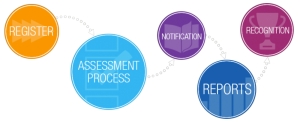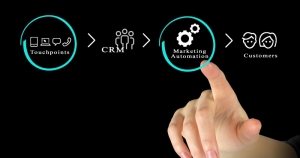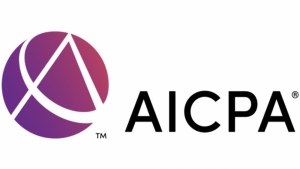عرض العناصر حسب علامة : شركات المحاسبة
هل شركتك من أفضل الشركات في مجال المحاسبة؟
معلومات إضافية
- المحتوى بالإنجليزية Is your firm one of the best in accounting? Participate in our 2021 Best Firms to Work For survey to find out!
عزز التسويق عبر الإنترنت لشركتك
بينما تبنى تجار التجزئة والشركات التجارية الموجهة للمستهلكين التسويق عبر الإنترنت منذ سنوات، كانت الممارسات المحاسبية بطيئة في تبني استراتيجيات التسويق الرقمي
معلومات إضافية
-
المحتوى بالإنجليزية
Power up your firm’s online marketing
By Lee Frederiksen
April 02, 2021, 11:07 a.m. EDT
5 Min Read
Facebook
Twitter
LinkedIn
Email
Show more sharing options
While retailers and consumer-oriented commercial businesses embraced online marketing years ago, accounting practices have been slow to adopt digital marketing strategies. The pandemic has hastened adoption, but for most firms the move to digital marketing remains more reactive than proactive. Many of the digital tools and techniques remain unfamiliar to senior firm management.
This issue has been compounded by decades of accounting marketing tradition rooted in the belief that new business is best developed through referrals. However, while referrals still happen, they are happening less frequently. Accounting services buyers are increasingly likely to research and conduct business online. If you want to gain their attention, you’re going to have to do it through a screen.
Fortunately, there are a number of online solutions, channels and approaches that are proven to help firms like yours effectively reach and engage target buyers. To develop your own online marketing strategy, you’ll need to focus on two fundamental lead-generating drivers: the online tools and the digital content that attract your target audience.
Managing Your Firm in a Post-COVID World
Think beyond the pandemic with exclusive resources to help you build a thriving virtual practice.
SPONSORED BY INTUIT ACCOUNTANTS
Reaching new-business prospects: Online tools that work
Effective online marketing is underpinned by several web-based tools that attract prospects to the top of the sales funnel. Each of these can successfully drive lead generation if utilized correctly:
Lead-generating website: Let’s face it. Most accounting websites are not dynamic, compelling marketing tools. They’re often jargon-filled, self-serving promotional vehicles focused on telling site visitors how great the firm is. To become a lead-generating machine, your website must clearly convey that your firm understands your prospects’ problems and needs and can provide solutions to address them. By offering potential clients valuable, objective information, you’re demonstrating what it would be like to work with you.
Search engine optimization (SEO): The vast majority of business professionals use the web to research the services they need. However, they will not find you unless the web knows you’re there. To do that, you need to optimize the content on your website so search engines — and, consequently, prospects — can find you. This is referred to as organic search and is primarily driven by having useful, authoritative content available on your website. It helps if that content is original.
Pay-per-click (PPC) advertising: While organic search is one of the most valuable and effective tools for attracting prospects, PPC can help you buy your way onto search engine results pages. It’s typically less expensive than traditional space advertising because you only pay when someone clicks your link and you can track and analyze your results to help make your campaign even more effective.
Online networking: This is the activity that takes place on social media. So while specific social media platforms (such as LinkedIn or Twitter) may be the actual tool, it’s the networking that happens on it that really engages with prospects. While the style of interaction may vary greatly from Twitter to LinkedIn to Facebook, it’s still about making the right connections with the right people. Just as with traditional networking, your level of success will be directly proportional to the amount of time and attention you invest in it.
Digital content: The fuel that drives your marketing engines
None of the above tools will work without relevant content to attract your target audience. Your content can take many forms, but several are particularly effective at attracting leads to your website and other online platforms:
Industry research reports: These are excellent lead generators. They attract prospects with highly valuable information while building your visibility, credibility and brand value. It’s critical, though, to choose research topics that are of exceptional interest to your target audience. As an added bonus, research reports provide an outstanding opportunity to partner with an industry trade association or a noncompeting firm. This can help reduce your marketing cost and increase your credibility through the implied endorsement by the industry group.
Webinars: Just like traditional seminars, webinars should be educational in nature — individuals will want to attend because they think they will learn something new and valuable about their issues or priorities. Webinars are typically offered free of charge. The value they provide to you is the registration information you gather from attendees, as well as market intelligence based on their questions and feedback, all of which can help you focus your marketing efforts and develop future topics.
Marketing videos: Well-produced, educational videos are excellent marketing tools for accounting firms. They can attract and nurture leads by providing valuable information about subjects of interest and helpful explanations about complex accounting and financial topics. Videos are also ideal for showcasing the expertise and experience of various members of your team.
White papers and e-books: Both of these are long-form, in-depth informational tools that make attractive pay-per-click offers and website giveaways in return for filling out a registration form. A little target audience research can quickly generate a list of appropriate topics of value that will attract your best prospects and encourage them to engage with your firm. A resource section on your website filled with e-books and white papers covering a wide range of valuable topics will go a long way in building your firm’s reputation as an industry expert and leader.
Blogging and guest blogging: Blog posts are an excellent driver of leads to your website. Blog posts are a cornerstone of almost any SEO campaign, providing opportunities to publish and distribute keyword-focused content that will boost your search engine rankings and attract prospects to your website.
Guest blogging is a great way to broaden your reach. If you have great content, it’s worth pitching it to publications or blogs that feature guest posts. This type of “earned media” can give your search engine ranking a lift and funnel readers to your site when you target high-authority online publications.
If you don’t already have an online marketing strategy, now is definitely the time to develop one. Combining online and traditional marketing to create an effective, comprehensive marketing program is an outstanding way to build your firm’s visibility and generate significant growth.
من أين يبدأ المسئول؟
يشير جاري بومر، قائد فكر إدارة التكنولوجيا والممارسة، إلى النقطة الحاسمة وهي أنه لكي تنجح شركات المحاسبة في الابتكار، يجب أن يكون شخص ما مسؤولاً عنها. سواء كانت شريكًا أو مسؤولًا رئيسيًا للابتكار أو حتى لجنة صغيرة، تحتاج الشركات إلى وضع وجه للابتكار، ومحاسبة شخص ما عن بناء وتعزيز ثقافة تشجع وتدعم الإبداع، والتي تستفيد من الأفكار الجديدة والطرق الجديدة للقيام بالأشياء، والتي تطور بشكل روتيني حلولًا جديدة. للتأكد من حدوث كل ذلك، يجب أن يكون هناك شخص مسؤول عنه بشكل منتظم.
معلومات إضافية
-
المحتوى بالإنجليزية
Where does the buck start?
By Daniel Hood
April 01, 2021, 9:00 a.m. EDT
2 Min Read
Facebook
Twitter
LinkedIn
Email
Show more sharing options
In a recent column, technology and practice management thought leader Gary Boomer makes the critical point that, for accounting firms to succeed at innovation, someone needs to be responsible for it. Whether it’s a partner or a chief innovation officer or even a small committee, firms need to put a face to innovation, to hold someone accountable for building and reinforcing a culture that encourages and supports creativity, that leverages fresh ideas and fresh ways of doing things, and that routinely develops new solutions through a systematized pipeline. To make sure all that happens, someone needs to be in charge of it on a regular basis. The buck, as they say, needs to stop somewhere.
But where does the buck start?
The simplest answer is: anywhere and everywhere. While ultimate responsibility for innovation in a firm must reside with a single person or very small group, innovation itself can come from multiple sources — from partners and entry-level staff, from clients and customers, from software vendors and joint venture partners, from everyone and anyone who can have an idea. In fact, one of the key responsibilities of a chief innovator is to make sure that everyone in the firm and within its sphere of influence feels empowered to innovate, to make suggestions, to dream up new services, new solutions, new methodologies and new processes. Imagination is no respecter of rank or propriety; good ideas can well up anywhere. (Our cover storyon technology and audit quality offers a great example: an associate at the most junior level built a data workflow and visualization for their own personal use that’s now saving countless hours for staff all across a Big Four firm — see page 6.)
Managing Your Firm in a Post-COVID World
Think beyond the pandemic with exclusive resources to help you build a thriving virtual practice.
SPONSORED BY INTUIT ACCOUNTANTS
Innovation can start with anyone; it can also start anywhere. Great ideas for improving a practice area can certainly come from the staff in those departments, but they can also come from their clients, or from admin staff who handle the billing for those services, or from the banker or lawyer who referred those clients to the firm. Good and interesting ideas pop up in all sorts of places — if you’re looking for and encouraging them.
Just as important as all that is the fact that innovation can come in a multitude of forms, and is definitely not limited to technology. To be sure, many innovative ideas can be substantially enabled by hardware and software, but that’s about elaboration, not origination, and it’s a mistake to expect that only the tech-savvy will be coming up with million-dollar ideas.
As with most everything else, innovation was accelerated by the COVID-19 pandemic. Dozens of firms created new solutions for figuring out when clients could safely reopen their offices, or built Paycheck Protection Program calculators, or otherwise dreamed up unusual ways to keep their clients afloat. Necessity was the mother of invention there, but necessity won’t necessarily disappear when the pandemic is over — just the perception of pressure. Clients will still need radical new solutions to changing environments, firms will still need to build them, and they will still need to encourage their development wherever they may spring up.
Innovation may be just a few people’s responsibility — but it should be part of everyone’s job.
أفضل استراتيجيات إدارة العملاء لشركات المحاسبة
كثيرًا ما نلاحظ أن مالكي شركات المحاسبة يهتمون كثيرًا بعملائهم. ومع ذلك، يعتقد العديد من الأفراد الذين يغيرون شركاتهم أنهم لم يتلقوا الرعاية المناسبة من محاسبهم السابق.
معلومات إضافية
-
المحتوى بالإنجليزية
Better client management strategies for accounting firms
By Jason Schow and Jason Blumer
March 09, 2021, 11:35 a.m. EST
6 Min Read
Facebook
Twitter
LinkedIn
Email
Show more sharing options
We frequently observe that accounting firm owners care a lot for their clients. Still, many individuals who change firms believe they didn’t receive the appropriate care from their previous accountant. There is a clear disconnect regarding the accounting professional’s intent.
This is a phenomenon that we directly experience with some new clients. They typically tell us that their last firm wasn’t proactive enough and didn’t provide the value they expected. Yet from interactions with hundreds of accounting professionals, we have seen firsthand that they generally care very much for the people they work with.
So how can the accounting profession provide clients with a high-value service that reflects the firm’s concern? The answer may be in the creation of an efficient client management strategy — an aspect that is often not given the proper attention as firms grow.
Managing Your Firm in a Post-COVID World
Think beyond the pandemic with exclusive resources to help you build a thriving virtual practice.
SPONSORED BY INTUIT ACCOUNTANTS
Client management is an essential aspect of leading and running a professional accounting firm efficiently and providing ongoing value to clients. Also, as your clients are the firm’s source of revenue, they are obviously central to your company’s sustainability and growth.
It is a good idea to manage each clients’ entire journey versus expecting them to decide how, when, and what they purchase from the firm.
A client management strategy has a model that each firm can follow to make sure they are providing the client care needed to keep their firm running and developing. Overlooking this ecosystem can impact resources and result in clients receiving a lower level of service.
There are three stages where client management is particularly important: onboarding, pricing, and more generally in your business model.
Client onboarding
This is the first step when you start working with a new client before they receive any services. Something that has stood out as good practice during this phase is to make sure the clients you take on are a good fit for the way you do business. This is key to building a sustainable firm that you and your staff enjoy.
The process of new client intake can be slowed down to a point where you can create a place for value judgments, where both you and the potential clients can decide to work together or not. When the sales process is slowed down like this, you can give comfort to the client while increasing the perceived value of your work.
Some aspects — or the entire process — can be virtualized, for example by using Zoom conferences and shared documents. It is now possible to operate a virtual firm, and with the current pandemic situation, it is even an encouraged practice.
The ultimate goal in the client-onboarding phase should be to align with the potential client, dive into real discovery of their needs, and prepare them to be priced.
Pricing
Pricing is the second phase and happens before the service begins. Determining value in pricing is generally a skill that takes time and practice to master. Here are some questions we suggest asking potential new clients to help define price:
Why are you looking for a new accountant? Why now?
What do you hope to achieve in working with our firm? What do you see in us that made you interested?
How will we know this is successful?
What has stopped your company from resolving this in the past? What might stop your company from achieving these results in the future?
What will your company look like in two years?
What keeps you up at night?
What gets you up in the morning?
What have you valued about past relationships with financial coaches or advisors?
If working with our firm requires more time from you, can you commit that time? What are you willing to say no to for our collaboration to be a success?
What are all the issues to be addressed?
Did we get it right? What did we not ask that we should have?
Here are some practical observations on different types of pricing:
Hourly billing lends itself to a faster, more commodity-based firm business model. Hourly billing takes no client assessment, no conversations as to what the client may value, and puts the client in control to let the firm know what to do. Hourly billing is the fastest form of running a firm, as it takes little time to bring new clients into the firm. Any client is welcome in a billing firm.
Fixed pricing applies a single price to a service that is offered by the firm. Note that this is different from value pricing, where only the client has a price. Firms that offer monthly packages are doing fixed pricing.
Value billing is another form of hourly billing, yet takes it one step further. When the bill is calculated, a value markup is applied if the client perceives higher value than when the services were started. This is a difficult model to operate within since the influence of value with a client begins at the outset of a relationship, not after the work has been completed.
Value pricing is the slowest form of a firm’s business model. In a value-pricing firm, there are essentially no prices for services. Only the clients have prices since all services can (and are) sold to them for different prices depending on what they value most.
Firms do not have to exclusively adopt one model of pricing or billing but can instead weigh their benefits and apply the different models to different client groups or to different divisions of a firm (in large organizations). For example, firms offering advisory services would lend themselves to value pricing done by the owners of the firm, while the accounting and tax recurring revenue of many firms is suitable for a fixed pricing model.
No matter which model of pricing is chosen in your client management strategy, value is the core component to help the client and firm align on the goals and payment of the service.
Business model
The business model is the final phase where service happens and is the team structure you use to deliver services.
The way you manage your company’s capacity is fundamental to your firm being able to create efficient profit. There are several pillars to capacity management:
Time and location: These are the more controllable aspects of capacity. A firm can request their team work a certain amount of time in locations that afford the greatest productivity and use of that capacity.
Mind and emotions: These elements are generally not controllable. These are simply what the humans working in the firm bring with them each day. They are not strategic at all, and you never know when issues may appear and prevent the professional from focusing on their work. Leaders of the firm should be able to identify any team inefficiencies if they want to create profit for their growth, investment, and distributions. Managing and strategically predicting capacity is the key to turning the right amount of revenue into efficient profit.
Project management: This is the management of the scope of your services, the assignment of work to the team members, and the management of related software products that this management resides in. Project management is the foundation of service and is how a firm owner knows what work is flowing through their firm and what is being managed properly.
This is a high-level overview of the client management journey, and we hope it helps as you navigate this topic. Client management is an important matter in any firm. Without a strong vision about what this means, both firm owners and clients will struggle. Tackling topics like client management sets a firm apart to provide immense value, which in turn justifies higher prices in the marketplace they serve.
7 طرق يمكن لشركات المحاسبة توظيفها للموسم المزدحم
بغض النظر عن مدى تأصل العمل الموسمي في مهنة المحاسبة، فإن مهمة تحديد المواهب القادرة وتوظيفها بكفاءة للانضمام إلى شركتك والبدء في العمل ليست سهلة أبدًا. ومع ذلك، فإن بعض الأساليب أكثر فعالية من غيرها.
معلومات إضافية
-
المحتوى بالإنجليزية
7 ways accounting firms can staff for busy season
By Tim Rowley
August 27, 2021 10:50 AM
Facebook
Twitter
LinkedIn
Email
Show more sharing options
No matter how ingrained seasonal work has become in the accounting profession, the task of identifying and efficiently staffing capable talent to join your firm and hit the ground running is never easy. Some approaches, however, are more effective than others.
Every firm is different, of course, but seasonal needs in the sector tend to be universal. And while many firms are rightly focused on scaling their business development funnel, it’s equally as important to have a robust pipeline of contractors who can be immediately activated when billable work hits its zenith. Especially during busy season, it can be advantageous to have efficient hiring practices in place that will not only seamlessly help a firm handle its work but also improve margins by forgoing the typical costs associated with W-2 employees.
Obviously, busy season can represent a disproportionate amount of business on your calendar. During this time, it’s critically important to retain clients but also meet margin objectives.
Busy-season staffing for accounting firms generally comes down to following a few simple rules. Follow them and you’ll be ready for the industry’s most critical time of year.
Secure your busy-season talent early
p1au7i02al11q412i8k5lcvk1ftm7.jpgA trend has emerged: Larger firms are beginning to focus on staffing for the busy season earlier and earlier in the annual cycle, with many extending offers as early as July and August for highly desirable contract resources — with contracts extending through the end of the 2022 busy season. If securing the best contract talent is the goal (and isn’t it always?), you’ll want to act fast. When is the best time to start planning around hiring for busy season? Right when the previous season ends. That way you can identify proven contractors you want to bring back the following year, make them an offer and guarantee that efficiency will be higher compared to contractors you might be working with for the first time.
Bring in contract recruiters
It’s settled then: The name of the game is identifying and locking up desirable contract talent first. So don’t let other firms beat you to the punch because you don’t have enough recruiters able to focus on staffing up for your busy-season needs. A skilled contract recruiter can quickly pay for their time with a few placements, but they may not be needed outside of the busy-season ramp-up. Like any business, accounting firms are always focusing on growth. So, even if you’ve brought back contractors from previous busy seasons, you’ll still need to staff up to support any new business layered on top of what’s recurring. Contract recruiters can take the worry out of securing that contract talent so you can focus on what’s important: the clients (servicing those existing and bringing aboard more).
Don’t lose out to firms willing to offer longer contracts
p19uuqo5cv17u181l174i199t1ma8c.jpgNot surprisingly, contractors are gravitating toward firms offering longer-duration contracts. In the past, a typical busy-season contract may have lasted three months. Today, these same contractors are being offered up to six months, with firms subsequently moving them around as needed to ensure their talents are fully utilized through the life of their contracts. With most work being done remotely, contractors can more easily be moved from one team to another. This tactic will also offer you the flexibility to bring on more business throughout the year. Though “busy season” is a milestone on the calendar of every accounting firm, business comes throughout the year. Signing contractors to longer engagements can actually reduce the spend you have to invest in recruiting. Plus, if you have the work for contractors over a longer period of time, you’re making money off of them anyway.
Consider leveraging the global talent pool
globe1.jpg
© Royalty-Free/CORBIS
For work that can be done remotely, consider utilizing contractors based outside the U.S. There are affordable, highly qualified contractors around the world with strong English-language skills who may be solid additions to your busy-season team. In some instances, these contractors may even be located in the same time zone as the rest of your team. Many of these international contractors have extensive Big Four backgrounds, as well as plenty of busy-season experience under their belts. An added benefit of contract workers in a different time zone? It means your firm can operate 24-7, providing a level of client service many do not.
Be prepared to move quickly
new-hire-fotolia.jpgIt is currently a candidate’s market, with desirable contractors typically entertaining multiple offers — including permanent work — and commanding premium compensation. Finding strong candidates in this environment is challenging, and recruiting firms simply don’t have many desirable candidates to present for most highly skilled jobs. This makes speed even more important. Instead of having to work through multiple layers in an organization to obtain approval, hiring managers should be empowered to select candidates themselves so they can move quickly when an attractive candidate is identified. If not, the ship will quickly sail.
Leverage a talent cloud
remote-meeting-woman.jpg
fizkes - stock.adobe.com
In order to develop a network of proven contractors with whom you can build enduring relationships, consider using a talent cloud. The firms that have the most success are those that invest in relationship-building year-round — firms that contractors view as true partners in their careers. Additionally, talent clouds help firms bring back contractors that have worked with them previously, often at lower costs. Talents clouds offer push-button hiring efficiency. Hiring managers can review contractors en masse, easily access references (without having to wait for calls back), all increasing hiring efficiency.
Don’t try to go it alone
For obvious reasons, contractors love fielding opportunities from several desirable employers. Firms that try to build their own proprietary contractor networks are at a fundamental disadvantage to talent cloud platforms, which work with many of the firms that top contractors are most interested in. The primary objective of a contractor is to secure enough work to provide a desirable income and lifestyle, which means waiting on just one firm to call them with opportunities is a luxury they can’t afford.
كيف يمكن لشركات المحاسبة الحماية من تهديدات أمان العمل عن بُعد؟
معلومات إضافية
-
المحتوى بالإنجليزية
How accounting firms can protect against remote work security threats
By Sarah A. Lynn, Douglas G. Schultz
July 14, 2021, 11:45 a.m. EDT
5 Min Read
Facebook
Twitter
LinkedIn
Email
Show more sharing options
The COVID-19 pandemic has fundamentally changed the way people work. Millions of employees have been able to stay productive while working from home during the lockdowns thanks to remote collaboration technologies like Zoom, WebEx and Teams. Very quickly, virtual meetings became ever-present, and people could connect with their managers and clients or give presentations from any location with internet access, including other countries. Even as much of the country returns to business (mostly) as usual, firms instituting flexible or work-from-home policies may need to review their telecommuting policies and practices to help keep data safe.
While working from home has been key to business continuity over the last 15 months, it has also opened up some potentially major security issues for firms. In an office setting, there are multiple ways to secure data, including firewalls and physical security measures such as badges, doors, locks and keys. However, remote employees could be working from their homes, their cars, or at a local coffee shop. They have laptops, mobile phones, tablets and smartwatches — all of which communicate with each other and could use several different services (Wi-Fi, Bluetooth, cellular data, RFID).
Being outside a secure office makes these employees, and their data — that is, your data and your client’s data — vulnerable to data leaks and hacks. Even something like a chat or text message could contain confidential information, such as a Social Security number, birth date, tax information, or even medical information.
This is why robust data security is vital for any company. Data breaches that compromise client or employee data are notoriously costly, averaging over $3.9 million in 2020. They not only hurt a firm's reputation and bottom line but can also result in the theft of client information, proprietary information or intellectual property. Think of all the due diligence-related information your firm has on clients who might be preparing for an IPO or merging with another company.
It's these risks, by the way, that drove the American Institute of CPAs to add to its Code of Professional Conduct Confidential Client Information Rule 1.700.001, which deals with disclosure of confidential client information without the specific consent of the client. This rule goes hand in hand with Internal Revenue Code Sec. 7216, where failure to comply can lead to fines and other consequences.
It is against that background that all firms must make a concerted effort to be vigilant about protecting their data and their client’s data. Accounting firm leaders must recognize the issues affecting their firms and take measures to educate their professionals. With that in mind, here are a few practical ways to help secure access to data, stay compliant, and mitigate the damage in the event of a breach.
Encryption is your friend
You may have outfitted all of your employees with laptops and a secure virtual private network. While a VPN might be enough protection when employees use their devices on a secure home network, what if they’re traveling or decide to work in a cafe? Many hotels, airports and cafes offer free Wi-Fi, but these unsecured networks can allow hackers to gain access to data that is supposed to be secure. A VPN may protect outbound data, but it still leaves the laptop or tablet itself vulnerable via other potentially active services such as Bluetooth, hotspots or RFID. Encrypting the device itself will make it much harder for criminals to access the data.
Encryption can also help protect a device if it is physically stolen. Unattended computers, tablets or mobile phones are tempting targets for thieves. With the device in their possession, the thief could have a treasure trove of confidential information they can sell or use to scam your clients. If a device is encrypted, the data is safe, and you only lose the device. It could mean the difference between $1,000 or $1,000,000.
Turn off services
Mobile devices are designed to make communication easy. This is a double-edged sword, however, unless there are security protections in place. For example, virtually all mobile devices have Bluetooth, and a growing number can be used as internet hotspots or have radio frequency identification (RFID) technology built right in. If these services are turned on, a hacker could potentially compromise the device. While these services can be beneficial, they do not need to be active 24/7. All employees should be instructed to turn them off until they are needed, especially while traveling.
Make sure to back up your data
With millions of Americans telecommuting, tens of millions of laptops and other devices are floating around filled with potentially sensitive data. This creates a greater chance that data could be lost if a device is lost, stolen or damaged. Employees should back up their devices daily, or at the very minimum, weekly, so the information will remain accessible if there is a catastrophic failure. Moreover, it is vital that employees restrict backups solely to company-approved destinations (e.g., cloud storage, on-premises servers, encrypted hard drives). If they make a backup to another location, it exposes their organizations to a potential data breach they have no control over.
As a firm leader, you should work with your IT team to ensure the mobile devices with access to firm information use properly “containerized” apps such that your firm’s data is automatically backed up, even if the rest of the device’s data is not. Note that even email and everyday collaboration tools are loaded with documents and sensitive data that could be easily leaked. To reiterate, always (1) encrypt the devices and (2) back up important information.
A few decades ago, it was practically unthinkable that employees would have access to a secure server from their home, or for them to be a potential target for hackers. Accounting firm leaders must adapt their security practices to the time and, perhaps most importantly, educate employees about cybersecurity. Even with just these three relatively simple steps, firms can significantly reduce the chances of being subject to a costly data breach or cybercrime incident.
عشاق البيتكوين، يبكون!
تقيد شركات المحاسبة الشركات العملاء من الاحتفاظ بالعملات المشفرة كأصول حتى في الوقت الذي تمنح فيه العنان لشركات رأس المال الاستثماري -مثل SoftBank Group Corp.-للاستثمار في حيدات ذات مخاطر متساوية ومتقلبة.
معلومات إضافية
-
المحتوى بالإنجليزية
Bitcoin lovers, cry foul!
Accounting firms are restricting corporations from holding the cryptocurrency as assets even as they give free rein to venture capital firms — such as SoftBank Group Corp. — to invest in equally risky and volatile unicorns. MicroStrategy Inc. and Elon Musk’s Tesla Inc. own Bitcoin but they are exceptions. One survey found that only 5% of finance executives plan to invest in Bitcoin this year.
That mindset is getting in the way of the broader adoption of Bitcoin and other cryptos because companies holding such digital currencies bear an accounting risk: big asset write-downs.
This is happening even though there are no official guidelines under GAAP over how companies should account for digital assets. Accountants are operating out of a consensus among auditors — in their “non-authoritative” voice as they try to define the new era in a new report — that cryptos are not considered cash, or financial instruments, but “indefinite-lived intangible assets” because they “lack physical substance.”
In general, intangible assets tend to be related to a company’s activities and operations — marketing, customer relations, technological skills or artistic expressions, says Allen Huang, accounting professor and associate dean at the Hong Kong University of Science and Technology’s business school. Classifying Bitcoin as such is a stretch. However, that’s where it is now as accountants try to fit crypto into existing categories. And, as an intangible asset, Bitcoin’s book value can go only one way: down.
If a company bought Bitcoin at $60,000, and the fiscal quarter ended with the crypto at $35,000, its investments will have to be impaired and written down to $35,000 per coin. The converse, however, is not true. A chief financial officer can’t write up her firm’s investments if the price goes back up to $60,000. She can do that only when the company sells the coins. This makes it difficult for a company to book gains on its crypto assets, while leaving open plenty of earnings downside.
In February, this concern was raised right after Tesla disclosed a $1.5 billion Bitcoin investment. It’s an important point. Depending on when exactly Tesla accrued its crypto pile, the EV maker might have to report an impairment for the June quarter. What blue-chip company wants to have that kind of headache on its balance sheet?
In contrast, stocks — classified as financial instruments — can easily be written up and down, thanks to what, in accountant-speak, is called “fair value, mark-to-market” bookkeeping. For instance, in the March quarter, venture capital giant SoftBank reported net income of 1.93 trillion yen ($17.5 billion), the most ever for a Japanese company, with essentially all of that due to unrealized gains from the newly public Coupang Inc. SoftBank owns over one-third of the South Korean e-commerce company.
It feels unfair. Often cash-burning, newly-listed unicorns — such as the now-infamous Didi Global Inc. — can be as risky as 12-year-old Bitcoin. Had these unicorns been classified as intangible assets, SoftBank and other VCs would not have been able to claim profits until they sold their holdings.
Nonetheless, the accountants hold sway. Companies with extra cash that are willing to take on risk will find it hard to go into crypto. Granted, many CFOs may stay away from crypto assets anyway because of volatile trading. But the less risk-averse would be deterred by a huge institutional roadblock: their accounting firms.
قم ببناء شركة المحاسبة الخاصة بك من خلال إتقان لغة أجنبية
معلومات إضافية
-
المحتوى بالإنجليزية
As an accountant, you're probably always thinking of ways that you could improve and grow your practice. Yes, you can buy the latest bookkeeping software and try out new email marketing strategies, but there is one often-overlooked method of attracting new clients: learning a foreign language. Here are just a few ways that mastering a new language will bring more success to your accounting business.
Connect with many new people
Most people in the workforce need to meet with accountants every year to handle their taxes. In addition, small-business owners who don’t have an in-house bookkeeper need to find the right accountant who can keep their enterprise’s financial health in order. If you reside in an area where a lot of the residents speak a certain language, learning their language can help you connect with them and possibly land them as clients.
ASC 842 and IFRS 16 Lease Accounting Software from CoStar
Lease accounting software from CoStar analyzes and classifies leases for new lease accounting requirements
PARTNER INSIGHTS
SPONSOR CONTENT FROM COSTAR
Those in your area who speak another language may feel more comfortable working with bookkeeping professionals who also speak their language, as they can better describe what financial help they need. Once you master their language, you can share on your business website’s “About Us” page and on your social media channels that your practice also offers services in their language. It may be what piques their interest in choosing you for their accounting needs over your competitors.
Also, don’t forget about the vast new network that you can tap into by learning a new language. So many people ask their friends and family members for advice on reputable accountants and other professionals who can provide services. Thus, every time you work with someone who speaks the language you now know, they might really admire your service and refer you to other members of their community. These referrals can really help you grow your business, especially during busy times like tax season. These are just a few of the advantages of learning a new language.
Maximize your potential as an accountant
As a bookkeeper or accountant, you always want to provide the best service you can for your clients. One way to do that is by improving your own abilities and skill set. Every single time you challenge yourself with a new goal you want to achieve, such as learning a new language, you will grow as a person.
To start, it will alter your brain in a positive way. Whenever you learn something new, your brain constructs a ton of new neural pathways and connections that develop white and grey matter. Studies show that these kinds of changes in the brain will also stem from mastering a new language. As you become fluent in a new language, your brain will develop advanced cognitive abilities and better multitasking capabilities. On top of this, your memory will improve. These benefits can help you better manage your accounting tasks and provide superior services for your clientele.
It will uplift you during difficult times. Are you currently helping a client with a stressful tax audit? Did a business client misplace a financial document you needed for their books? Yes, our accounting careers can be filled with taxing situations (no pun intended), and we may feel stressed out at times. This is why it is vital to take part in exciting endeavors that can provide the perfect morale boost to help keep you motivated. If you achieve your goal of mastering a new language, you will experience immense satisfaction with the accomplishment.
If you are looking for ways to grow your accounting firm, mastering a new language can be key for growing your enterprise. It will help you attract a whole new market of potential clients, who can also spread the word about your services to their family and friends. On top of this, learning a new language will help you be the best accountant you can be, as it will change your brain for the better and give you a morale boost that will help keep you motivated during tough times. So what are you waiting for? Start your journey of learning a new language today!
معهد المحاسبين الإداريين IMA ينتخب الرئيس القادم
عين معهد المحاسبين الإداريين جوين فان بيرن، المدير المالي لمركز تنسيق شبكة الإنترنت الأوروبي ( RIPE NCC ) ، لتكون سادس رئيسة منتخبة
معلومات إضافية
-
المحتوى بالإنجليزية
IMA elects incoming chair
By Michael Cohn
The Institute of Management Accountants named Gwen van Berne, CFO of the internet registry agency RIPE NCC, as its sixth female chair-elect and the first to reside abroad.
Van Berne is based in the Netherlands and runs the finances of the official regional internet registry for Europe, the Middle East and parts of Central Asia. She will succeed Steve McNally, CFO of Plastic Technologies, as IMA chair next year.
The move comes as the accounting profession tries to increase gender diversity in its ranks. Last month, the IMA released a report in conjunction with the California Society of CPAs showing a significant diversity gap at the senior ranks of the U.S. accounting profession (see story). The report found that men comprise 86 percent of the CFOs of Fortune 500 and S&P 500 companies and 77 percent of partners in accounting or finance functions at U.S. CPA firms.
“The accounting profession needs to be a trailblazer for a diverse and inclusive workplace,” said van Berne. “The IMA is doing a lot to make sure that we start off the conversation and also that we show in our actions that we really think this is a very serious matter. The study clearly shows a lot of work needs to be done in this area. if you look at the accounting profession, women actually comprise a greater proportion of the profession than men compared to the overall U.S. population, but based upon the workforce statistics, they are underrepresented in the senior roles.”
While many women are studying accounting in college and getting entry-level jobs, they don’t seem to be advancing at the same rate as men. “The accounting pipeline is filled with women, but we don’t see that same pipeline generating the senior roles,” said van Berne. “There we still see a majority of men. That same research study shows that in every 10 senior roles, only two are filled by women. It's very clear that we still have a lot of work to do to make sure that we get more gender equality. We are a firm believer that diversity leads to better results and more objective, unbiased decision-making. It can generate a kaleidoscope of views and insights and different personalities. It’s really important for accounting even more than for other professions. We really need to set the tone.”
The accounting profession is increasingly turning female. In 1983, 38 percent of accounting professionals were women. Fast forward to 2020, and the share of women is 61 percent. “Our profession is apparently becoming more female, but we don't see the same effect on all those levels,” said van Berne. “That’s something we hope to change, but it's not only about gender issues in the research.”
At the same time, ore than 90 percent of the profession’s executive leadership are white. In contrast, only 1 percent of partners at U.S. CPA firms in 2018 were Black, 2 percent were Latino and 4 percent were Asian. In corporate America, only 1.4 percent of CFOs at S&P 500 companies in 2019 were Black, 1.6 percent were Latino and 4.9 percent were Asian.
“It’s not only about the females, but also diversity,” said van Berne. “I really hope that we can go a bit quicker than the last 100 years have shown.” Women only got the vote in the U.S. in 1920, she noted, and in the Netherlands in 1919.
As CFO of RIPE NCC, van Berne is in charge of the finances of one of five regional internet registries in the world. She is also the treasurer of the Delft Chamber Music Festival in the Netherlands. “It was a difficult year for musicians with the pandemic,” she said. “These are really challenging times financially.”
Female leaders face not only the perennial problem of the “glass ceiling,” but also the “sticky workforce,” according to van Berne.
“With the internal barriers that women are facing, they sometimes hold themselves back,” she said. “They should take a bit more risk and negotiate more. The research study shows that a lot of women really feel that sometimes their working environment is not supportive. They experience a hostile work environment, which is not good, and they struggle with stereotyped expectations. If women are looking to move up into senior management roles and they are negotiating and taking risks, sometimes they are seen as being too aggressive or not a good team player. What we expect from women is that they are very sensitive and caretakers, which are all very important qualities and I think every leader should have them too. In my experience, sometimes you need more of the male skills because the CFO is a leader. I can’t always have my caretaker hat on.”
The IMA and CalCPA study found that 73 percent of females feel their leaders demonstrate unfair prejudice or bias against women that negatively affects promotion in the accounting and finance function. “I wish this were different and hopefully in the future it will be,” said van Berne. “This is for sure a conversation that we need to have with the men. That’s also important. You’ll never get there if you’re only going to discuss this with women alone. The inclusive part of it is what creates success in the end.”
معهد المحاسبين القانونيين يرقي سو كوفي لمنصب الرئيس التنفيذي للمحاسبة العامة
معلومات إضافية
-
المحتوى بالإنجليزية
AICPA promotes Sue Coffey to CEO of public accounting
By Michael Cohn
The Association of International Certified Professional Accountants has promoted longtime AICPA executive Sue Coffey to the new position of CEO of public accounting.
Coffey has been a top leader at the AICPA for many years who has taken on more of a global role after the American Institute of CPAs teamed on a joint venture with the U.K.’s Chartered Institute of Management Accountants to create the Association of International Certified Professional Accountants in 2016.
Prior to her new role, she was executive vice president of public practice at the Association. As part of her newly expanded role, she will partner with AICPA president and CEO Barry Melancon in setting strategy and strengthening the profession. She will continue to report to him, but the move sets her up as a likely successor to Melancon, 62, who has been leading the AICPA since 1995 and is its longest-serving chief.
“This is a tremendous achievement and reflects Sue’s leadership and strategic capabilities, plus the hard work and success of Sue and her team,” Melancon said in a statement Thursday. “Her foresight and global network have been key to the success of many innovations, such as the soon-to-be-launched Dynamic Audit Solution, the modernization of auditing standards and the re-envisioning of CPA licensure to address accountants’ emerging skills and competency needs.”
Managing Your Firm in a Post-COVID World
Think beyond the pandemic with exclusive resources to help you build a thriving virtual practice.
SPONSOR BY INTUIT ACCOUNTANTS
In her newly expanded role, Coffey will help Melancon spearhead some of the main initiatives at the AICPA, including the rollout of new advisory and assurance services, and expanding the CPA pipeline. Coffey will also work on developing relationships with other leaders and stakeholders in the profession, including alliances with U.S. and international firms, along with government and private organizations, and their leaders. She will work closely with Andrew Harding, the Association’s CEO of management accounting, and Erik Asgeirsson, CEO of the AICPA’s technology and business unit CPA.com. Her initial focus will be working with members to understand how the Association can better support them and their clients, as well as develop strategies to foster new technologies like CPA.com’s Dynamic Audit Solution.
“I am incredibly honored and excited to be assuming this new role,” Coffey said in a statement. “Many past and present Association leaders, as well as CPA firm leaders whom I’ve worked with over the years, have supported and prepared me for this challenging role. I am eternally grateful to them. My new role will allow me to engage my strategic thinking, relationship-building and problem-solving experience in finding new ways to support and grow the profession and its commitment to protecting the public.”
Coffey is a licensed CPA in the states of New York and New Jersey, as well as a CGMA, and is a member of the New Jersey Society of CPAs. She was named to Accounting Today's 2020 Top 100 Most Influential People in Accounting list. She graduated with a Bachelor of Science degree in accounting from Fairfield University in Fairfield, Connecticut.










